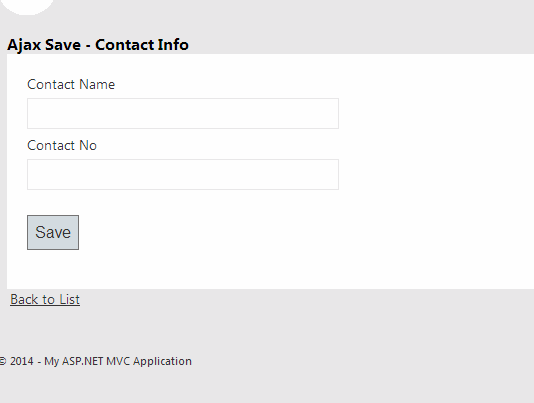Introduction
In the previous example we have seen that How to insert data into sql server database using jquery (post method) in asp.net MVC 4 Application. But there was not used AntiForgeryToken.AntiForgeryToken is used for prevent CSRF (Cross Site Request Forgery) attack. CSRF is a way of hack where hacker exploits the trust of a website on the user.
Here we will see How to insert data into sql server databse using jquery with Preventing CSRF Attacks in asp.net MVC 4 Application.
Steps :
Step - 1 : Create New Project.
Go to File > New > Project > Select asp.net MVC4 web application > Entry Application Name > Click OK > Select Internet Application > Select view engine Razor > OKStep-2: Add a Database.
Go to Solution Explorer > Right Click on App_Data folder > Add > New item > Select SQL Server Database Under Data > Enter Database name > Add.Step-3: Create table for fetch data.
Open Database > Right Click on Table > Add New Table > Add Columns > Save > Enter table name > Ok.Step-4: Add Entity Data Model.
Go to Solution Explorer > Right Click on Project name form Solution Explorer > Add > New item > Select ADO.net Entity Data Model under data > Enter model name > Add.A popup window will come (Entity Data Model Wizard) > Select Generate from database > Next >
Chose your data connection > select your database > next > Select tables > enter Model Namespace > Finish.
Step-5: Apply Validation On Model.
Open your model and add validation. Please follow below code
namespace MVCAjaxSave
{
using System;
using System.Collections.Generic;
using System.ComponentModel.DataAnnotations;
public partial class ContactInfo
{
public int ID { get; set; }
[Required(ErrorMessage="Contact Name required!", AllowEmptyStrings=false)]
public string ContactName { get; set; }
[Required(ErrorMessage="Contact No required!", AllowEmptyStrings=false)]
public string ContactNo { get; set; }
}
}
Step-6: Add a new Controller.
Go to Solution Explorer > Right Click on Controllers folder form Solution Explorer > Add > Controller > Enter Controller name > Select Templete "empty MVC Controller"> Add.Step-7: Add new action into your controller for save data.
Here I have added "Save" Action into "Ajax" Controller. Please write this following code
public ActionResult Save()
{
return View();
}
Step-8: Add view for the Action & design.
Right Click on Action Method (here right click on form action) > Add View... > Enter View Name > Select View Engine (Razor) > Check "Create a strong-typed view" > Select your model class > Add.[N:B:Please Rebuild solution before add view.]
Step-9: Add jquery code for save data to the server.
Jquery Code
<script>
$(document).ready(function () {
$("#AjaxPost").click(function () {
$("#content").html("<b>Please Wait...</b>");
var dataObject = {
ContactName: $("#ContactName").val(),
ContactNo : $("#ContactNo").val()
};
// Here Add validation token with dataObject
dataObject.__RequestVerificationToken = $("input[name=__RequestVerificationToken]").val();
$.ajax({
url: "@Url.Action("Save","Ajax")",
type: "POST",
data: dataObject,
dataType: "json",
success: function (data) {
if (data.toString() == "Successfully Saved!") {
$("#ContactName").val('');
$("#ContactNo").val('');
$("#content").html("<div class='success'>"+data+"</div>");
}
else {
$("#content").html("<div class='failed'>" + data + "</div>");
}
},
error: function () {
$("#content").html("<div class='failed'>Error! Please try again</div>");
}
});
});
});
</script>
Complete View
@model MVCAjaxSave.ContactInfo
@{
ViewBag.Title = "Ajax Save - Contact Info";
}
<style>
.success {
border:solid 1px rgb(13,109,0);
width:300px;
padding:5px;
background-color:rgb(215,255,218);
}
.failed {
border:solid 1px red;
width:300px;
padding:5px;
background-color:rgb(255,229,229);
}
</style>
<h2 style="font-size:12pt; font-weight:bold;">Ajax Save - Contact Info</h2>
@using (Html.BeginForm()) {
@Html.ValidationSummary(true)
@Html.AntiForgeryToken()
<fieldset style="background-color:#ffffff">
<legend>Contact Info</legend>
<div style="padding:20px;">
<div class="editor-label">
Contact Name
</div>
<div class="editor-field">
@Html.EditorFor(model => model.ContactName)
@Html.ValidationMessageFor(model => model.ContactName)
</div>
<div class="editor-label">
Contact No
</div>
<div class="editor-field">
@Html.EditorFor(model => model.ContactNo)
@Html.ValidationMessageFor(model => model.ContactNo)
</div>
<p>
<input type="button" value="Save" id="AjaxPost"/>
</p>
<div id="content">
</div>
</div>
</fieldset>
}
<div>
@Html.ActionLink("Back to List", "Index")
</div>
@section Scripts {
@Scripts.Render("~/bundles/jqueryval")
<script>
$(document).ready(function () {
$("#AjaxPost").click(function () {
$("#content").html("<b>Please Wait...</b>");
var dataObject = {
ContactName: $("#ContactName").val(),
ContactNo : $("#ContactNo").val()
};
// Here Add validation token with dataObject
dataObject.__RequestVerificationToken = $("input[name=__RequestVerificationToken]").val();
$.ajax({
url: "@Url.Action("Save","Ajax")",
type: "POST",
data: dataObject,
dataType: "json",
success: function (data) {
if (data.toString() == "Successfully Saved!") {
$("#ContactName").val('');
$("#ContactNo").val('');
$("#content").html("<div class='success'>"+data+"</div>");
}
else {
$("#content").html("<div class='failed'>" + data + "</div>");
}
},
error: function () {
$("#content").html("<div class='failed'>Error! Please try again</div>");
}
});
});
});
</script>
}
Step-10: Add another action into your controller for Save Data to the server.
Here I have added "Save" Action into "Ajax" Controller for POST Action. Please write this following code
[HttpPost]
[ValidateAntiForgeryToken]
public ActionResult Save(ContactInfo CI)
{
string message = "";
if (ModelState.IsValid)
{
try
{
using (MyDatabaseEntities dc = new MyDatabaseEntities())
{
dc.ContactInfoes.Add(CI);
dc.SaveChanges();
message = "Successfully Saved!";
}
}
catch (Exception ex)
{
message = "Error! Please try again.";
}
}
else
{
message = "Please provide required fields value.";
}
if (Request.IsAjaxRequest())
{
return new JsonResult { Data = message, JsonRequestBehavior = JsonRequestBehavior.AllowGet };
}
else
{
ViewBag.Message = message;
return View(CI);
}
}
Step-11: Run Application.
Download Application Live Demo
- How to insert data into sql server databse using jquery (post method) in asp.net
- How to insert data into sql server databse using jquery (post method) in asp.net MVC 4 Application.




